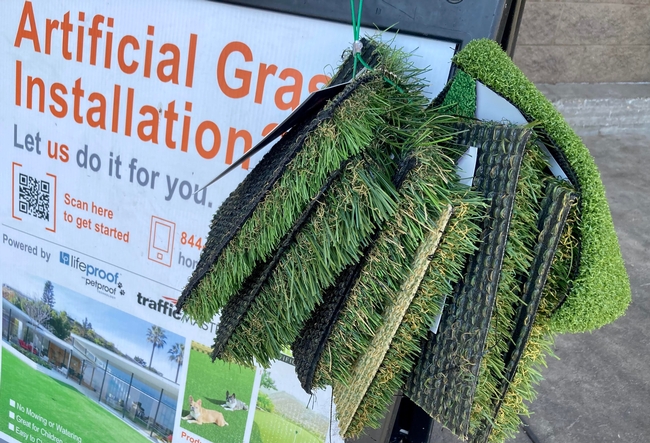Facing costly water bills and stringent municipal water limits, some Fresno County residents and businesses are opting to replace their lawns with synthetic grass. However, research by UC Cooperative Extension environmental horticulture advisor Janet Hartin has found that fake lawns have significant drawbacks.
To begin with, synthetic lawns are superheating what are already urban heat islands like those found in Fresno County. In the City of Fresno, for example, the average summer temperature is 4° F higher than in rural areas due to the urban heat island effect. (CalEPA)
Hartin conducted her research in Palm Springs and Redlands. While average summer temps are 5 to 10 degrees higher in Palm Springs than in Fresno, temperatures in Redlands are very similar. Hartin measured the surface temperatures of synthetic lawns, black mulch, asphalt and plants between 3 and 3:30 p.m. on several dates between May and August for the last three years.
“The surface temperature of asphalt, synthetic lawns and black mulch were more than 65° hotter than plants in Palm Springs and 60° higher in Redlands,” Hartin said. “The highest temperature I recorded was 173 on synthetic turf in Palm Springs. Black asphalt adjacent to the synthetic turf got as hot as 170°.”
The surfaces of plants she measured for comparison – groundcovers, vegetables and turfgrass lawns – hovered around 90° to 95° in Redlands and 95° to 100° in the desert.
“Plants are so much cooler because of their transpiration, the process in which the plant releases water vapor back into the atmosphere, cooling plants and their surroundings. Non-living surfaces don't transpire, so they will never be as cool as a living surface,” she said.
The surfaces of concrete and light-colored mulches were warmer than living green areas, but not nearly as hot as surfaces of darker-colored materials.
More and more, sports fields are being converted to synthetic turf because of its durability and lower water and maintenance needs. However, the hotter surface when the weather is warm, and rigid base compared to the sponge-like quality of natural turf, has led to an increase in injuries, Hartin said.
“Managers of schoolgrounds, parks, playgrounds and sports fields in inland and desert communities should choose living grass over synthetic materials,” Hartin said. “Because of California water woes, the days of wall-to-wall grass in front and back yards should be behind us, but we don't want to get totally away from grass. Other alternatives to consider are drought-resistant groundcovers.”
Another concern is disposing of the fake grass when it is removed. According to the synthetic grass industry, the product is expected to last for 20 years. (Synthetic Turf Council) After that, it is difficult to recycle, so typically ends up in landfills.
Grass, on the other hand, is easy to recycle. Throughout California, mowed grass clippings – along with other green waste like leaves, prunings and leftover food - are being picked up separately from garbage and composted. The grass clippings play a key role in the quality of the compost produced by municipal recycling programs.
“Compost is best created when ‘browns,' like fallen leaves, are combined with ‘greens,” like fresh grass clippings, in a 50/50 ratio. After adding moisture and regular turning, the product is ideal for nurturing soil,” Hartin said. “Or, the clippings can be used as a mulch on the surface of soil to reduce weeds, conserve water and keep plant roots cool. You can't do that with fake grass.”
Grow plants instead
Hartin believes the best surfaces in front and back yards are living plants. Green living surfaces not only cool the environment, they provide habitat for pollinators and food for birds. Earth worms and healthy microbes break down organic matter under turf and groundcovers, which improves soil quality. Climate-appropriate plants also help reduce stormwater runoff and reduce soil erosion.
"The cooling and ecosystem benefits of growing plants outweigh their water and maintenance requirements," she said. “What we plant today is going to benefit the community for decades to come."
Read more:
In the valley, 'heat islands' of asphalt and fake lawn reach 170 degrees. What you can do, Janet Hartin, The Desert Sun
Once hailed as a drought fix, California moves to restrict synthetic turf over health concerns, CalMatters
Synthetic sports fields and the heat island effect, Sonia Myrick, National Recreation and Park Association Magazine


